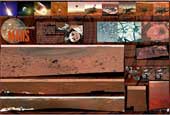
 |
|
|
|
On 26 July 1609, Thomas Harriot became the first person to make a drawing of an astronomical body with a telescope – over three months before Galileo. Harriot remained an obscure figure in scientific history for well over 200 years after his death in 1621 and it was not until the late twentieth century that he became of international scholarly recognition and study. The Harriot Lectures, delivered since the 1960s at Oxford and Durham Universities, now testify to that recognition and the ten lectures delivered between 1990 and 1999 are presented in essay form in this volume. Each of the ten lecturers is an acknowledged authority in his or her field and reflects the several facets of Harriot’s own scientific and scholarly interests, including case studies in scientific instrumentation, American exploration, mathematics, atomism and religion. James Bennett, John Roche, Hilary Gatti and John North in particular deal with the central role which astronomical and physical thinking played in Harriot’s career, including his observational work, Copernican and Keplerian ideas, his ideas on the nature of matter (atoms) and of course, his early telescopic observations. I was especially fascinated by Hugh Trevor Roper’s chapter (which I vividly recall hearing delivered as a lecture in 1992) on Harriot’s final illness, medical condition and correspondence with his physician, Sir Theodore Mayerne. This volume is a work of the highest scholarly standard, yet each of the essays is beautifully written and easily accessible to the non-specialist. It brings to life not only Harriot himself, but also the world in which he lived. Allan Chapman |
|
|
|
2009 Yearbook This 132-page special edition features the ultimate observing guide for 2009, a review of all the biggest news stories of 2008, in depth articles covering all aspects of astronomy and space missions for 2009, previews of International Year of Astronomy events and much, much more. This 132-page special edition features the ultimate observing guide for 2009, a review of all the biggest news stories of 2008, in depth articles covering all aspects of astronomy and space missions for 2009, previews of International Year of Astronomy events and much, much more.Infinity Rising  This special publication features the photography of British astro-imager Nik Szymanek and covers a range of photographic methods from basic to advanced. Beautiful pictures of the night sky can be obtained with a simple camera and tripod before tackling more difficult projects, such as guided astrophotography through the telescope and CCD imaging. This special publication features the photography of British astro-imager Nik Szymanek and covers a range of photographic methods from basic to advanced. Beautiful pictures of the night sky can be obtained with a simple camera and tripod before tackling more difficult projects, such as guided astrophotography through the telescope and CCD imaging.Exploring Mars  Astronomy Now is pleased to announce the publication of Exploring Mars. The very best images of Mars taken by orbiting spacecraft and NASA's Spirit and Opportunity rovers fill up the 98 glossy pages of this special edition! Astronomy Now is pleased to announce the publication of Exploring Mars. The very best images of Mars taken by orbiting spacecraft and NASA's Spirit and Opportunity rovers fill up the 98 glossy pages of this special edition!Mars rover poster  This new poster features some of the best pictures from NASA's amazing Mars Exploration Rovers Spirit and Opportunity. This new poster features some of the best pictures from NASA's amazing Mars Exploration Rovers Spirit and Opportunity. |
||||||||||||||||||||||||